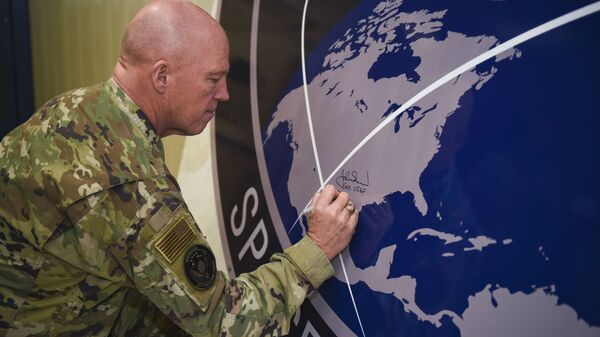Titled “Spacepower,” the capstone publication lays out many of the basics of how the USSF understands its mission, methods and domain.
“One of the principles of an independent service is the creation of doctrine,” USSF Chief of Space Operations Gen. Jay Raymond said in a USSF news release on Monday. “The Space Capstone Publication explains why spacepower is a vital element of US prosperity and security - now and in the future - and guides its employment in multidomain operations. As the USSF continues to grow and mature, we will continue to evolve our doctrine to stay on the cutting edge of defending our interests in space.”
According to the document, the Space Force brings together space capabilities formerly operated as ancillary fields in support of their own domains. The doctrine thus “elevates spacepower as a distinct formulation of military power on par with landpower, seapower, airpower, and cyberpower.”
Spacepower, it says, concerns the space domain, which is defined as the “altitude where atmospheric effects on airborne objects becomes negligible.” This makes spacepower an inherently global concern, the doctrine notes, and because space assets are operated by surface-based personnel, space operations are also inherently multi-domain.
However, the US military’s definition of space is different from more common delineations. Most official determinations, such as by the Fédération Aéronautique Internationale, use the Kármán Line, which is 62 miles above sea level, but the Pentagon and the American space agency NASA place the border 12 miles lower, at 50 miles up, according to the US National Oceanographic and Atmospheric Administration (NOAA).
Perhaps the doctrine’s most salient point lies in seeing in “military spacepower a critical manifestation of the high ground” from which the Space Force can, through “deterrent and coercive capacities,” provide national military leadership with options in support of other forms of military power.
In other words, the USSF is seen as key to everything else the Pentagon does. Navigation and communications down on planet Earth are almost totally dependent on space assets which must be defended, and now that there is a Space Force dedicated to defending them, they can be vastly expanded and even turned into offensive weapons of their own.
Following the position of the Trump administration, the Space Force pins the necessity of this evolution - and its own existence - on foreign adversaries like Russia and China. Although neither country is named in the document, it notes that “our potential adversaries’ actions have significantly increased the likelihood of warfare in the space domain.”
As Sputnik has reported, the issue is not that Russia, China or any other country are threatening to militarize space or have recently begun to, but that until recently, the United States was the only country to have done so, which is why it was not a problem for US defense policy before.
One of the key weapons drawing US ire is anti-satellite missiles, which Russia tested earlier this year and China has tested as early as 2007. However, the US was the first nation to demonstrate such a capability way back on September 13, 1985, when it shot down the “Solwind” solar observation satellite using an ASM-135 ASAT missile fired from a specially modified F-15 Eagle. However, the US has been testing anti-satellite weapons almost since Sputnik 1 was launched by the USSR in 1957, including the May 24, 1963, test of a nuclear-armed Nike-Zeus missile that destroyed an AGENA D satellite.
Some of the more recent weapons deployed by the Space Force are ground-based jammers intended to target enemy satellites.
Meanwhile, the Trump administration has fervently dodged attempts by Beijing and Moscow to halt an arms race in space before it begins.



